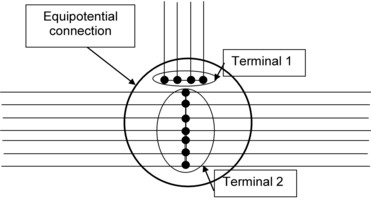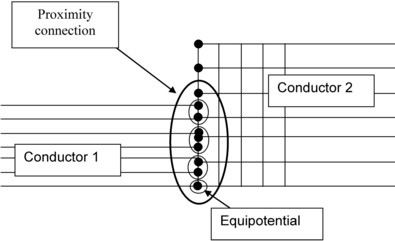Connections: about
Definition
In Flux PEEC, a connection is a junction between terminals; it represents one or more nodes in the equivalent PEEC circuit that the software will have to build before solving the project.
As for any electric circuit, a node of the PEEC electric circuit is a junction where the algebraic sum of the currents from all the branches connected to this point is zero.
There are two types of connection in Flux PEEC:
- equipotential connection
- proximity connection
They are described below.
Equipotential connection
An equipotential connection connects terminals of components and/or unidirectional conductors and/or terminals of the point type of bidirectional conductors.
One node is set for this connection of the equivalent PEEC circuit in the sense that all mesh elements of concerned unidirectional conductors are gathered, as shown in the figure below.

As a result of this juncture, all terminals involved in the connection have the same electrical potential.
Proximity connection
A proximity connection can only be between two terminals of the face type of unidirectional or bidirectional conductors which are in contact.
One or more nodes are set for this connection of the equivalent PEEC circuit in the sense that one or more equipotential connections are established between mesh elements of concerned unidirectional conductors, as shown in the figure below.

These equipotential connections are automatically created by the software according to the spatial distribution of two involved terminals.